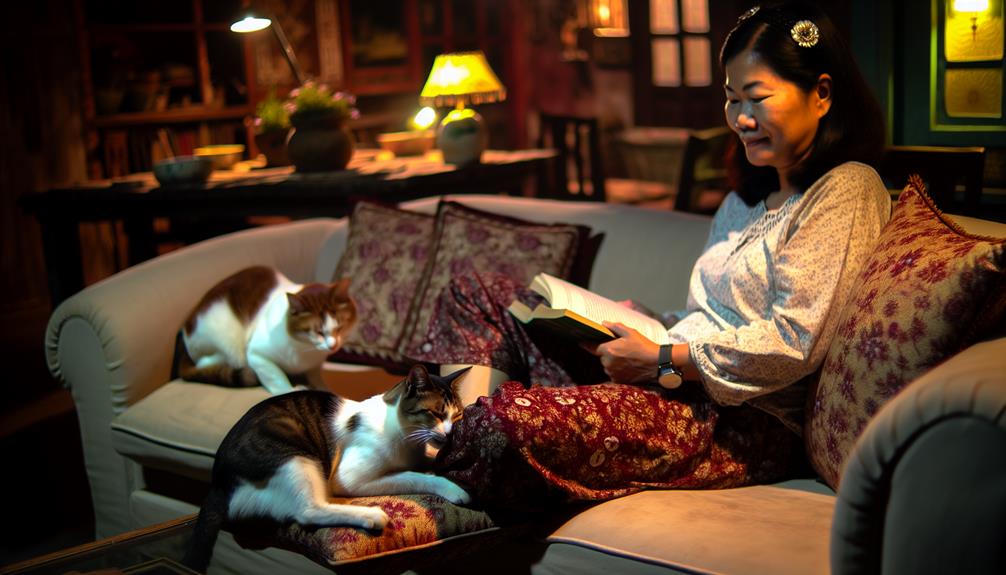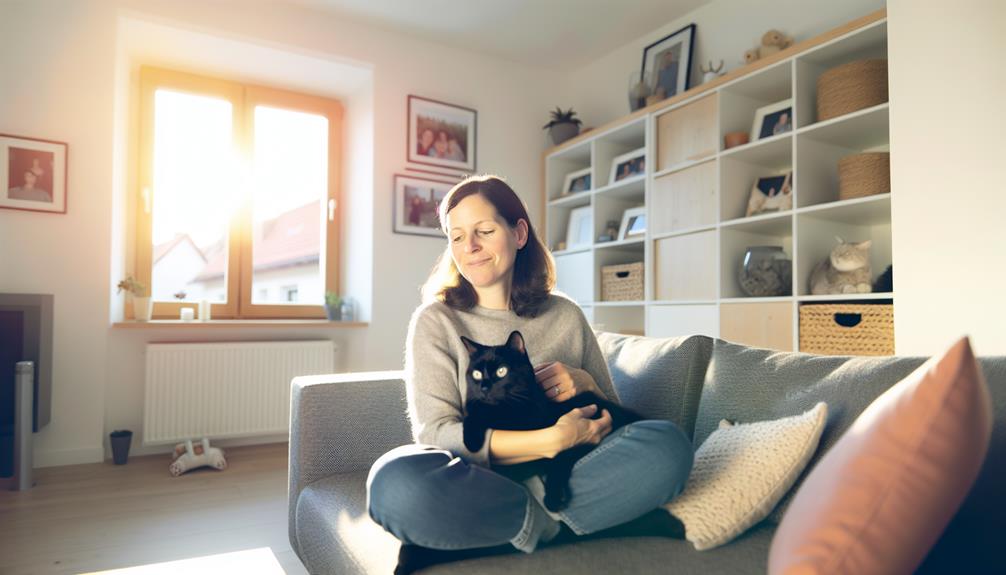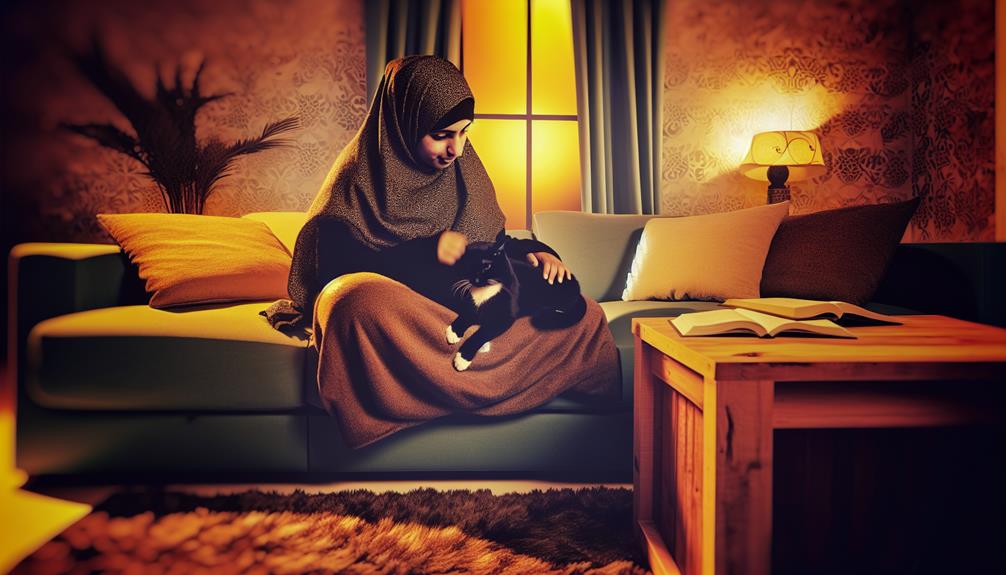You've probably pondered whether your cat truly loves you or if they're just indulging in your hospitality. While cats may not express affection like dogs do, they're certainly capable of forming deep bonds with their owners. Subtle behaviors such as purring, slow blinking, and head-butting are more than just quirks; they signify trust and emotional connection. Scientists have even linked these behaviors to the release of oxytocin, the "love hormone," during interactions. But what do these gestures really mean, and how do they compare to other pets' expressions of love? Let's explore further.
Understanding Feline Affection
How do cats truly show affection? Understanding feline affection requires a keen observation of cat communication and feline body language. Unlike dogs, cats have a more subtle approach to demonstrating their fondness. You might not immediately recognize these signs unless you know what to look for.
First, purring is a primary indicator of a cat's contentment and affection. While purring can also indicate discomfort, a cat that nuzzles, kneads, or curls up on your lap while purring is likely expressing affection. Pay attention to the frequency and context of the purring as part of broader cat communication signals.
Next, observe your cat's tail. A tail held high, often with a slight curve at the tip, indicates confidence and friendliness. If your cat wraps its tail around you or another cat, it's a clear sign of affection. This behavior is rooted in feline body language, signifying trust and comfort.
Additionally, slow blinking or "cat kisses" are significant. When a cat looks at you and slowly blinks, it's a gesture of trust and affection. Return the gesture to strengthen your bond.
Head-butting or bunting is another affectionate behavior. Cats have scent glands on their heads, and by rubbing against you, they're marking you with their scent, signifying ownership and affection. This is a profound part of their body language repertoire.
Lastly, grooming you or other cats indicates a high level of trust and affection. This mutual grooming, known as allogrooming, is a social activity that reinforces bonds within social groups.
Understanding these behaviors in the context of cat communication and feline body language will help you recognize and appreciate the subtle ways your feline companion expresses affection.
Scientific Evidence of Cat Love
Often overlooked, the scientific evidence supporting the notion that cats experience love is both compelling and growing. Researchers have shed light on various physiological and behavioral aspects that suggest cats form emotional bonds with their owners. One such area of study is the purring frequency. Cats purr not only when they're content but also when they're in need of comfort or connection. This dual-purpose behavior indicates a complex emotional landscape where purring serves as a means of expressing attachment.
Eye contact also plays a pivotal role in understanding feline affection. Studies have shown that mutual gazing between cats and their owners releases oxytocin, often referred to as the "love hormone," in both parties. This hormonal response is similar to what occurs between human mothers and their infants, suggesting a deep, emotional bond.
To help you grasp these scientific findings more effectively, here's a concise table summarizing the key evidence:
| Evidence Type | Description | Implication |
|---|---|---|
| Purring Frequency | Cats purr when content or in need | Indicates emotional complexity |
| Oxytocin Release | Eye contact boosts oxytocin levels | Suggests deep emotional bonding |
| Behavioral Studies | Observations of attachment behaviors | Supports the presence of affection |
These findings are not just anecdotal but rooted in rigorous scientific research. They offer a clinical perspective on how cats may indeed show love towards their owners. By understanding these aspects, you can appreciate the depth of the bond you share with your feline companion, grounded in observable and measurable phenomena.
Behavioral Signs of Attachment

Recognizing behavioral signs of attachment in cats provides valuable insight into their emotional worlds. While felines are often perceived as independent, their interactions can reveal deep bonds with their owners. One key indicator of attachment is purring. The gentle purring vibrations you feel when your cat nestles close can signify comfort and contentment. Scientific studies suggest that purring not only benefits the cat but also serves as a form of communication, indicating trust and attachment to their human companions.
Another important behavioral sign is head bunting, commonly referred to as head bonks. When your cat rubs its head against you, it's not merely seeking attention. This behavior is rooted in a complex system of scent-marking. Cats have scent glands located on their heads, and by marking you with their scent, they signal inclusion in their social group. This act can be interpreted as an affectionate gesture, highlighting a strong bond.
Additionally, a cat's willingness to follow you around the house is another sign of attachment. This behavior indicates that your presence provides a sense of security. Cats may also show attachment through kneading, where they rhythmically push their paws against you. This behavior stems from kittenhood and is a sign of comfort and contentment.
Lastly, consider the slow blink. When a cat gives you a slow blink, it's a sign of trust and relaxation. In the feline world, closing their eyes in the presence of another being indicates vulnerability and trust. When your cat offers this gesture, it's a clear indication of their attachment to you.
These behaviors collectively offer a window into your cat's emotional state, affirming their attachment and affection towards their human companions.
Comparing Cats and Dogs
When comparing cats and dogs, it's important to take into account their distinct evolutionary backgrounds and domestication processes, which have shaped their behaviors and interactions with humans. Dogs were domesticated from wolves around 20,000 to 40,000 years ago, evolving into highly social animals with a strong pack mentality. This has fostered dog loyalty, making them inclined to form intense bonds with their human caregivers. Cats, on the other hand, were domesticated from solitary wildcats around 9,000 years ago. Their independent nature is a reflection of their solitary ancestors, resulting in more varied cat personalities.
From a scientific perspective, these differences manifest in how each species interacts with humans:
- Social Structures: Dogs thrive in packs, where loyalty to the leader (you) is paramount. Cats, being solitary hunters, do not rely on a social hierarchy, which translates to more independent behaviors.
- Attachment Styles: Dogs often display secure attachment, seeking constant companionship and reassurance from their owners. Cats exhibit a wider range of attachment styles, including secure, ambivalent, and even avoidant attachments.
- Communication: Dogs have evolved complex social cues and behaviors to communicate with humans, such as barking and tail wagging. Cats use more subtle cues like purring, slow blinking, and body language, making their affection harder to interpret.
Understanding these evolutionary and behavioral distinctions is vital for interpreting your pet's actions and forming realistic expectations. While dog loyalty may seem more overt and consistent, cat personalities offer a unique and equally rewarding form of companionship, provided you recognize and respect their individual behaviors.
Real-Life Stories of Cat Bonds

While understanding the evolutionary and behavioral distinctions between cats and dogs provides a framework for interpreting your pet's actions, real-life stories of cat bonds illustrate the depth and diversity of feline companionship. Consider the case of Max, a formerly feral cat who transformed into a loving companion for his owner, Lisa. Initially wary and elusive, Max gradually displayed affectionate behaviors, such as purring moments and gentle head-butts, indicating his growing trust and emotional attachment to Lisa. This change underscores the potential for deep bonds, even in felines with a rough start.
Another compelling instance is the story of Oliver and his owner, John. Oliver, a tabby with an adventurous spirit, engages in playful interactions with John, including fetching small toys and initiating hide-and-seek games. These activities not only highlight Oliver's playful nature but also reflect a mutual understanding and connection. Scientifically, such interactions can be linked to the release of oxytocin, often termed the "love hormone," which fosters bonding in both humans and animals.
In a more poignant scenario, consider the elderly cat, Whiskers, who provided emotional support to her owner, Mary, during a prolonged illness. Whiskers consistently sought physical closeness, offering comfort through her presence and soft purring moments. This behavior aligns with research indicating that pets can have therapeutic effects on their owners, reducing stress and promoting emotional well-being.
These anecdotes emphasize that cat-human relationships can be as complex and meaningful as those with any other pet. Through purring moments and playful interactions, cats demonstrate a capacity for deep emotional bonds, challenging the misconception that they are aloof or indifferent.
Conclusion
To sum up, cats do form genuine emotional bonds with their owners. For instance, consider a cat named Whiskers who consistently purrs and head-butts his owner after a long day. This behavior isn't random; it's backed by science, revealing a release of oxytocin, the "love hormone," similar to human affection. By recognizing and nurturing these signs, you'll deepen your bond, affirming that cats, much like dogs, are capable of profound love and attachment.
